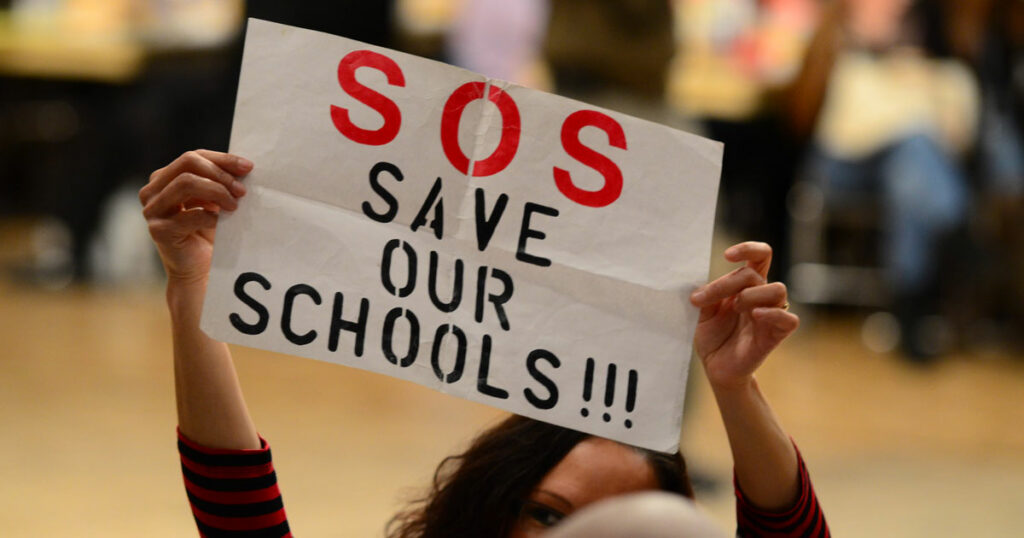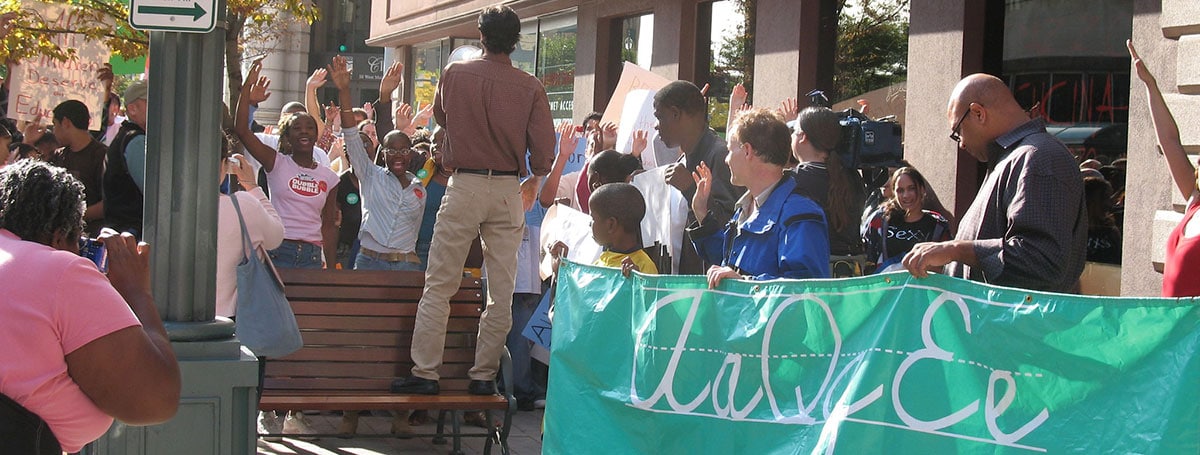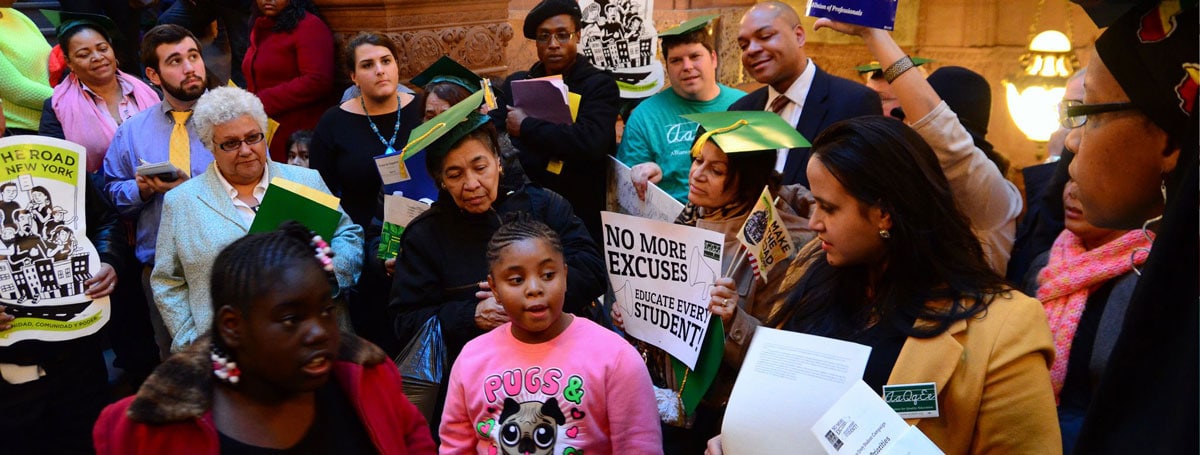Blog
The inside story behind how billions were won for New York’s public schools by students, families, teachers and activists

“THE SCHOOL AID IN THIS YEAR’S STATE BUDGET HAS THE POTENTIAL TO CHANGE THE EXPERIENCES AND OPPORTUNITIES OUR CHILDREN HAVE IN THEIR PUBLIC SCHOOLS FOR YEARS TO COME. THIS HAS BEEN A LONG FIGHT, FAR TOO LONG FOR THE TENS OF THOUSANDS OF STUDENTS WHO WERE BORN, EDUCATED AND GREW INTO ADULTS WHILE WAITING FOR THE FUNDING AND RESOURCES THAT SHOULD NEVER HAVE BEEN DENIED THEM. THIS WAS ALWAYS ABOUT CHILDREN AND WHAT THEY NEED.”
— JASMINE GRIPPER, ALLIANCE FOR QUALITY EDUCATION EXECUTIVE DIRECTOR, APRIL 2021
The massive, downright Dickensian difference in funding between schools that sometimes are mere blocks from each other has been a hallmark of New York’s public education system for generations. Until this past spring, when everything changed. What caused a massive policy shift — worth billions of dollars — in the face of a seemingly permanent funding crisis?
In 2007, a lawsuit concluded in a victory for public schools and New York State agreed, under court mandate, to commit more than $5.5 billion in funding over four years, a major step toward racial and economic equity in education. 70% of that funding was to go to the lowest-income school districts, whose property tax bases couldn’t compare with those of wealthier cities and neighborhoods. Unfortunately, this funding, known as Foundation Aid, never fully materialized. Between the 2008 financial crisis and a wave of budget cuts, what should have been a decade of equity became one of austerity. And as is always the case when state governments tighten their belts, low-income and BIPOC residents bore the brunt of it.

But the campaign was always more than just a lawsuit: it was at the heart of a renaissance of education justice organizing across the state. The strategic approach advocates took in crafting this campaign back in 1993 is what drew the Schott Foundation — itself having just been founded — to provide the initial funding for the lawsuit. Because while attorneys were making arguments in courthouses, parents, students and educators were organizing and mobilizing in their communities. This was the start of the Alliance for Quality Education, formally founded in 2000, with a goal to get the $5+ billion students were owed and equitably fund New York public schools.
Hundreds of thousands of New Yorkers and hundreds of organizations joined together in the Alliance for Quality Education (AQE) campaigns, led with the organizing skill of AQE’s then-executive director Billy Easton, and successfully won desperately needed revenue for New York’s Black and brown students. It was the Alliance that inspired them to demonstrate in their upstate towns and cities, to travel on bus tours across the state, to march to Albany. It was the Alliance that continued to beat the drum and connect with its communities – through wins and defeats – continuing actively for over a decade.
In addition, these tireless organizing and communications campaigns continued to make ever-stronger cases for funding equity to policymakers under the capitol dome. Its researchers kept the pressure up on the administration, releasing dozens of reports, and launching a database to show how just much each school was owed. It linked up with groups like Citizen Action of New York, Make the Road New York, New York Communities for Change and the NYC Coalition for Educational Justice to broaden and strengthen the education justice movement.

In the last several years, the hard-fought battles, consistent parent and youth organizing — and two 150-mile marches to Albany! — began to pay off, with notable if insufficient increases in state funding for public schools and Foundation Aid. Now that the state legislature this spring made Foundation Aid a guaranteed and permanent part of the New York State budget after a three-year phase in, communities around the state can breathe a bit easier. This is a victory New Yorkers can celebrate and everyone in the country can draw inspiration from.
AQE changed the frame and way of supporting public education, engaging grassroots action across the state of New York, from the City to upstate, inspiring newly formed intergenerational and multi-ethnic groups joining together in a more powerful state alliance. Demonstrations, bus tours, rallies and marches were organized. Their grassroots communications and advocacy style completely transformed a big state’s education funding system. This movement of grassroots groups of students, families, teachers and citizen activists were inspired and didn’t give up. These movements grew stronger.
As AQE Executive Director Jasmine Gripper put it:
“THE GOAL OF THE CAMPAIGN FOR FISCAL EQUITY LAWSUIT AND FUNDING THE FOUNDATION AID FORMULA WAS TO GIVE OUR SCHOOLS A SHOT IN THE ARM: AN INFUSION OF RESOURCES TO RAISE THE STATE’S FUNDING UP TO THE MINIMUM LEVEL REQUIRED FOR EVERY CHILD TO GET A ‘SOUND, BASIC EDUCATION.’ NOW, WE CAN TURN AHEAD AND BEGIN THE WORK TO CARRY EDUCATIONAL JUSTICE FORWARD.”
“The fight to hold the state to its obligation to fund public education has always been deeply steeped in racial justice; the majority of foundation aid remaining is due to school districts with 40 percent or more black and latinx students. The full funding of foundation aid that will be provided to schools over the next three years represents a major step toward racial and economic equity in education.”

This campaign is a model for other states around the country.
AQE is a leader of the coalition of organizations that garnered this win. Like many major social and political shifts, this one took many years: thirty, in fact. And the folks at the AQE campaign never let up or gave up. Here are a few examples of their tenacity:
- The Educate NY Now Express bus tour in 2012 made over 25 stops across the state to highlight the growing scope of the education crisis touching all school districts — urban and suburban, high need, average need and low need. The statewide bus tour stops included: Buffalo, Batavia, Olean, Rochester, Syracuse, Utica, Hornell, Naples, Elmira, Binghamton, Otego, Canton, Broadalbin-Perth, Mayfield, Yonkers, Kingston, Cohoes, South Colonie, Troy, Albany, Greenville, Long Island, New York City
- Cynthia Nixon & AQE’s 2011 “Protect Kids Not Millionaires” Campaign highlighted the stark difference in priorities between public school parents and the legislators who represented them.
- Over 1,500 students and education organizers rallied in Albany on January 2014 to demand fair school funding in New York State. Led by the Alliance for Quality Education (AQE) and Citizen Action of New York, both OTL allies, the organizers called for a $1.9 billion investment in public schools to begin reversing five years of budget cuts and fixing an education system fraught with inequality.
- 2014’s #WeCantWait Student campaign was a viral hit, with students posting selfies holding signs of what they wanted equitable funding to support, everything from smaller class sizes to libraries, to after school programs.
Outstanding Black women lead the organization today, parent leaders who gained their skills and expertise within the movement they became leaders for. Two members of AQE’s leadership include:

Jasmine Gripper
Jasmine Gripper, AQE’s executive director, started out as a classroom teacher. Realizing that education policies are often decided by those with little to no classroom experience, she left teaching and turned to organizing in order to affect genuine change and address the growing opportunity gap. Gripper joined aqe in 2013 as a temporary statewide organizer and rose quickly to become legislative director. In 2016, gripper was named as one of City and State Magazine’s 40 under 40 rising stars. Jasmine Gripper was born and raised in Queens. she is a proud graduate of the New York City public school system and CUNY’s Hunter College.

Zakiyah Ansari
Zakiyah Ansari is a parent, organizer, and advocacy & New York City director for the alliance for quality education. ansari is the mother of eight children and grandparent of three, and she has spent two decades as a community organizer fighting against educational injustice and the oppression of black and brown people. in 2017, Ansari was named one of City & State magazine’s 25 most influential people in Brooklyn. She also volunteers with justice league NYC.
We all must keep fighting. That’s how systemic change happens. That’s how the arc of history is bent toward justice.


